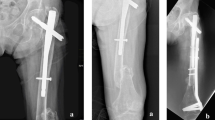Abstract
Purpose
To assess outcomes for patients who sustained peri-implant fractures (PIFs).
Methods
Medical records of patients who sustained a PIF were reviewed for demographic, injury, outcome, and radiographic data. PIFs were classified using a reproducible system and stratified into cohorts based on fracture location. Clinical outcomes were evaluated for each cohort.
Results
Fifty-six patients with 61 PIFs with at least 6 months of follow-up were included. The mean age of the cohort was 60.4 ± 19.5 years. Twenty-two (36.1%) PIFs occurred in males, while 39 (63.9%) occurred in females. Fifty-two (85.2%) PIFs were sustained from a low-energy injury mechanism. PIFs were most often treated with plate/screw constructs (50.8%). Complications included: 6 (9.8%) nonunions, 5 of which were successfully treated to healing, 5 (8.2%) fracture related infections (FRI), and 1 (1.6%) hardware failure. Sixty (98.4%) PIFs ultimately demonstrated radiographic healing.
Conclusion
PIFs are usually treated surgically and have a relatively high incidence of complications, with nonunion in femoral PIFs being the greatest. Despite this, the rate of ultimate healing is quite high.



Similar content being viewed by others
References
Müller F, Galler M, Zellner M et al (2016) Peri-implant femoral fractures: the risk is more than three times higher within PFN compared with DHS. Injury 47(10):2189–2194. https://doi.org/10.1016/j.injury.2016.04.042
Skála-Rosenbaum J, Džupa V, Bartoška R et al (2016) Distal locking in short hip nails: Cause or prevention of peri-implant fractures? Injury 47(4):887–892. https://doi.org/10.1016/j.injury.2016.02.009
Jennison T, Yarlagadda R (2018) Mortality in patients sustaining a periprosthetic fracture following a previous extracapsular hip fracture fixation. Injury 49(3):702–704. https://doi.org/10.1016/j.injury.2018.01.001
Downey C, Kelly M, Quinlan JF (2019) Changing trends in the mortality rate at 1-year post hip fracture—A systematic review. World J Orthop 10(3):166–175. https://doi.org/10.5312/wjo.v10.i3.166
Chan LWM, Gardner AW, Wong MK et al (2018) Non-prosthetic peri-implant fractures: classification, management and outcomes. Arch Orthop Trauma Surg 138(6):791–802. https://doi.org/10.1007/s00402-018-2905-1
Ma CH, Chiu YC, Wu CH et al (2019) Plate-on-plate technique for treating peri-implant fractures of distal femoral locking plate: a retrospective study of 11 patients. Arch Orthop Trauma Surg 139(9):1245–1251. https://doi.org/10.1007/s00402-019-03185-9
Brady OH, Garbuz DS, Masri BA, Duncan CP (2000) The reliability and validity of the Vancouver classification of femoral fractures after hip replacement. J Arthroplasty 15(1):59–62. https://doi.org/10.1016/s0883-5403(00)91181-1
Rorabeck CH, Taylor JW (1999) Classification of periprosthetic fractures complicating total knee arthroplasty. Orthop Clin North Am 30(2):209–214. https://doi.org/10.1016/s0030-5898(05)70075-4
Abdel MP, Cottino U, Mabry TM (2015) Management of periprosthetic femoral fractures following total hip arthroplasty: a review. Int Orthop 39(10):2005–2010. https://doi.org/10.1007/s00264-015-2979-0
Ebraheim NA, Kelley LH, Liu X, Thomas IS, Steiner RB, Liu J (2015) Periprosthetic distal femur fracture after total knee arthroplasty: a systematic review. Orthop Surg 7(4):297–305. https://doi.org/10.1111/os.12199
Ruchholtz S, Tomás J, Gebhard F, Larsen MS (2013) Periprosthetic fractures around the knee-the best way of treatment. Eur Orthop Traumatol 4(2):93–102. https://doi.org/10.1007/s12570-012-0130-x
Videla-Cés M, Sales-Pérez JM, Sánchez-Navés R et al (2019) Proposal for the classification of peri-implant femoral fractures: retrospective cohort study. Injury 50(3):758–763. https://doi.org/10.1016/j.injury.2018.10.042
Egol KA, Carlock KD, Kelly EA et al (2019) Previous implant fractures: a new descriptive classification system. J Orthop Trauma 33(9):423–427. https://doi.org/10.1097/BOT.0000000000001499
Lee JY, Soh T, Howe TS et al (2015) Bisphosphonate-associated peri-implant fractures: a new clinical entity? a series of 10 patients with 11 fractures. Acta Orthop 86(5):622–626. https://doi.org/10.3109/17453674.2015.1036339
Dupaix JP, Opanova MI, Lee LSK et al (2019) Denosumab-associated peri-implant atypical femur fracture: a case report. Hawaii J Health Soc Welf 78(11 Suppl 2):47–51
Park KC, Lim SJ, Song YS et al (2017) Factors affecting peri-implant fracture following locking plate for osteoporotic distal femur fractures. Orthop Traumatol Surg Res 103(8):1201–1204. https://doi.org/10.1016/j.otsr.2017.08.008
Zura R, Xiong Z, Einhorn T et al (2016) Epidemiology of fracture nonunion in 18 human bones. JAMA Surg 151(11):e162775. https://doi.org/10.1001/jamasurg.2016.2775
Lua J, Tan VH, Sivasubramanian H et al (2017) Complications of open tibial fracture management: risk factors and treatment. Malays Orthop J 11(1):18–22. https://doi.org/10.5704/MOJ.1703.006
Ziran BH, Darowish M, Klatt BA et al (2004) Intramedullary nailing in open tibia fractures: a comparison of two techniques. Int Orthop 28(4):235–238. https://doi.org/10.1007/s00264-004-0567-9
Karl JW, Olson PR, Rosenwasser MP (2015) The epidemiology of upper extremity fractures in the United States, 2009. J Orthop Trauma 29(8):e242–e244. https://doi.org/10.1097/BOT.0000000000000312
Clement ND, Yousif F, Duckworth AD et al (2012) Retention of forearm plates: risks and benefits in a paediatric population. J Bone Joint Surg Br 94(1):134–137. https://doi.org/10.1302/0301-620X.94B1.27155
Seigerman D, Lutsky K, Fletcher D et al (2019) Complications in the management of distal radius fractures: How do we avoid them? Curr Rev Musculoskelet Med 12(2):204–212. https://doi.org/10.1007/s12178-019-09544-8
Calori GM, Colombo M, Bucci MS et al (2016) Complications in proximal humeral fractures. Injury 47(Suppl 4):S54–S58. https://doi.org/10.1016/j.injury.2016.07.039
Savvidou OD, Zampeli F, Koutsouradis P et al (2018) Complications of open reduction and internal fixation of distal humerus fractures. EFORT Open Rev 3(10):558–567. https://doi.org/10.1302/2058-5241.3.180009
Funding
No funding was received for conducting this study.
Author information
Authors and Affiliations
Corresponding author
Ethics declarations
Conflict interest
The authors have no relevant financial or non-financial interests to disclose.
Ethical approval
This is an Institution Review Board approved study.
Additional information
Publisher's Note
Springer Nature remains neutral with regard to jurisdictional claims in published maps and institutional affiliations.
Rights and permissions
About this article
Cite this article
Perskin, C.R., Seetharam, A., Mullis, B.H. et al. Peri-implant fractures of the upper and lower extremities: a case series of 61 fractures. Eur J Orthop Surg Traumatol 32, 467–474 (2022). https://doi.org/10.1007/s00590-021-03005-0
Received:
Accepted:
Published:
Issue Date:
DOI: https://doi.org/10.1007/s00590-021-03005-0




